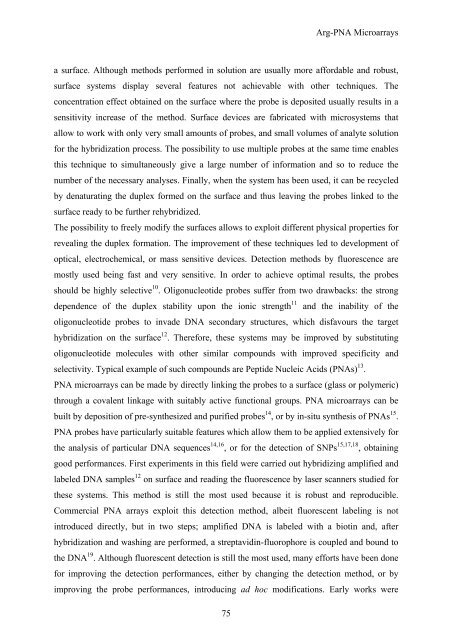View - DSpace UniPR
View - DSpace UniPR
View - DSpace UniPR
You also want an ePaper? Increase the reach of your titles
YUMPU automatically turns print PDFs into web optimized ePapers that Google loves.
Arg-PNA Microarrays<br />
a surface. Although methods performed in solution are usually more affordable and robust,<br />
surface systems display several features not achievable with other techniques. The<br />
concentration effect obtained on the surface where the probe is deposited usually results in a<br />
sensitivity increase of the method. Surface devices are fabricated with microsystems that<br />
allow to work with only very small amounts of probes, and small volumes of analyte solution<br />
for the hybridization process. The possibility to use multiple probes at the same time enables<br />
this technique to simultaneously give a large number of information and so to reduce the<br />
number of the necessary analyses. Finally, when the system has been used, it can be recycled<br />
by denaturating the duplex formed on the surface and thus leaving the probes linked to the<br />
surface ready to be further rehybridized.<br />
The possibility to freely modify the surfaces allows to exploit different physical properties for<br />
revealing the duplex formation. The improvement of these techniques led to development of<br />
optical, electrochemical, or mass sensitive devices. Detection methods by fluorescence are<br />
mostly used being fast and very sensitive. In order to achieve optimal results, the probes<br />
should be highly selective 10 . Oligonucleotide probes suffer from two drawbacks: the strong<br />
dependence of the duplex stability upon the ionic strength 11 and the inability of the<br />
oligonucleotide probes to invade DNA secondary structures, which disfavours the target<br />
hybridization on the surface 12 . Therefore, these systems may be improved by substituting<br />
oligonucleotide molecules with other similar compounds with improved specificity and<br />
selectivity. Typical example of such compounds are Peptide Nucleic Acids (PNAs) 13 .<br />
PNA microarrays can be made by directly linking the probes to a surface (glass or polymeric)<br />
through a covalent linkage with suitably active functional groups. PNA microarrays can be<br />
built by deposition of pre-synthesized and purified probes 14 , or by in-situ synthesis of PNAs 15 .<br />
PNA probes have particularly suitable features which allow them to be applied extensively for<br />
the analysis of particular DNA sequences 14,16 , or for the detection of SNPs 15,17,18 , obtaining<br />
good performances. First experiments in this field were carried out hybridizing amplified and<br />
labeled DNA samples 12 on surface and reading the fluorescence by laser scanners studied for<br />
these systems. This method is still the most used because it is robust and reproducible.<br />
Commercial PNA arrays exploit this detection method, albeit fluorescent labeling is not<br />
introduced directly, but in two steps; amplified DNA is labeled with a biotin and, after<br />
hybridization and washing are performed, a streptavidin-fluorophore is coupled and bound to<br />
the DNA 19 . Although fluorescent detection is still the most used, many efforts have been done<br />
for improving the detection performances, either by changing the detection method, or by<br />
improving the probe performances, introducing ad hoc modifications. Early works were<br />
75
















